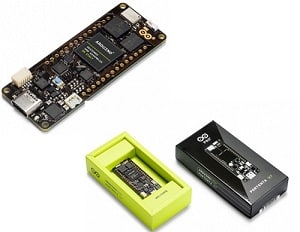- element14’s newest product offering, the Arduino Portenta H7 helps small-medium businesses and makers ease IoT development
- It includes exciting features such as high processing power, wireless connectivity and simple coding support
 element14 has added the latest Portenta H7 from Arduino to its extensive range of single-board computers (SBCs). The device targets growing demand from enterprise, small-medium business (SMB) and professional makers for low-code modular hardware systems that support IoT development. The Arduino Portenta family provides low-power boards designed specifically for industrial applications, artificial intelligence (AI) edge processing and robotics, whilst introducing a new standard for open high-density interconnect to support advanced peripherals.
element14 has added the latest Portenta H7 from Arduino to its extensive range of single-board computers (SBCs). The device targets growing demand from enterprise, small-medium business (SMB) and professional makers for low-code modular hardware systems that support IoT development. The Arduino Portenta family provides low-power boards designed specifically for industrial applications, artificial intelligence (AI) edge processing and robotics, whilst introducing a new standard for open high-density interconnect to support advanced peripherals.
The Arduino Portenta H7 module includes everything needed to get started with IoT hardware development including crypto-authentication chip and communications modules for Wi-Fi, Bluetooth Low Energy and LTE, as well as Narrowband IoT. Its low-code application development platform with modular hardware, allows users to build, measure and iterate without lengthy integration projects. Users also benefit from the value and usability of the new Arduino IoT application development platform (Arduino IoT cloud, Pro IDE with cloud integration, IoT UI editor) to help simplify product development and deployment.
Its combination of performance and flexibility makes the board suitable for applications where performance is key, such as High-end industrial machinery, Laboratory equipment, Computer vision, PLCs, Industry-ready user interfaces, Robotics, Mission-critical devices, Dedicated stationary computer and High-speed booting computation.
Features include:
- Processor: STM32H747XI dual-core ARM Cortex-M7 and M4 32bit low power Arm MCU, both running at 480 MHz and 240 MHz, respectively.
- Connectivity:
- The onboard wireless module enables simultaneous WiFi and Bluetooth connectivity. The WiFi interface can be operated as an Access Point, a Station or as a dual-mode simultaneous AP/STA and can handle up to 65 Mbps transfer rate. Bluetooth interface supports Bluetooth Classic and BLE.
-
- 10/100 Ethernet PHY.
- High-Speed USB PHY.
- Memory: includes options up to 64 MByte of SDRAM, and 128 MByte of QSPI Flash.
- Video: Display port over USB-C port.
- Encryption: NXP SE050C2 Crypto.
- GPIO:The Portenta family creates a new standard for pinouts adding two 80 pin high-density connectors at the bottom of the board to ensure scalability for a wide range of applications.
- SD card support:Interface for SD Card connector (through expansion port only).
- Coding support: can run Arduino code, Python and Javascript
- Operating temperature: –40 degrees Celsius to +85 degrees Celsius (excluding Wireless module) / -10 degrees Celsius to +55 degrees Celsius (including Wireless module).
Cliff Ortmeyer, Global Head of Technical Marketing for Farnell and element14 said, “The Arduino Portenta H7 combines outstanding performance and flexibility and can be used like any other embedded microcontroller board, or as the main processor of an embedded system. It’s also capable of running processes created with TensorFlow Lite, so you could have one of the cores computing a computer vision algorithm, whilst the other delivers low-level operations such as controlling a motor, or acting as a user interface. This gives small and medium businesses and professional makers the tools to develop IoT solutions without having to invest in specialized engineering resources.”
A wide range of Arduino products in the MKR and Nano family along with the Portenta H7 is available from Farnell in EMEA, Newark in North America and element14 in APAC.






